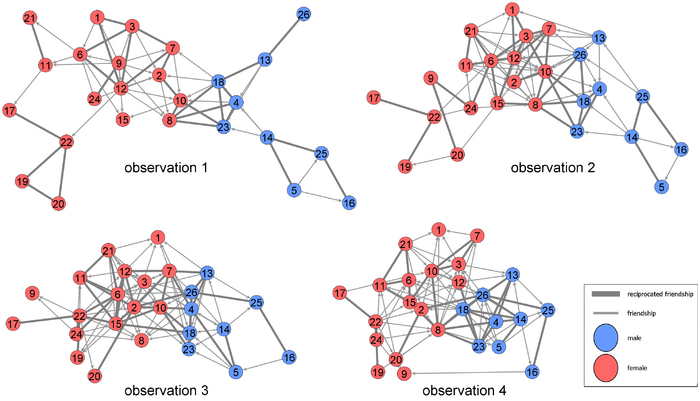Knecht Classroom (data)
The Knecht Classroom Data were collected by Andrea Knecht (see Knecht A. (2008). Friendship Selection and Friends' Influence. Dynamics of Networks and Actor Attributes in Early Adolescence. PhD dissertation, University of Utrecht.). The full data set contains a large number of classrooms - we use only the one described and available on the the Siena webpage.
Backround (see description on the the Siena webpage -> data sets)
This data is about a friendship network in a Dutch school class. The data were collected between September 2003 and June 2004 by Andrea Knecht, supervised by Chris Baerveldt, at the Department of Sociology of the University of Utrecht (NL). The entire study is reported in Knecht (2008). The project was funded by the Netherlands Organisation for Scientific Research NWO, grant 401-01-554.
The 26 students were followed over their first year at secondary school during which friendship networks as well as other data were assessed at four time points at intervals of three months. There were 17 girls and 9 boys in the class, aged 11-13 at the beginning of the school year. Network data were assessed by asking students to indicate up to twelve classmates which they considered good friends.
Delinquency is defined as a rounded average over four types of minor delinquency (stealing, vandalism, graffiti, and fighting), measured in each of the four waves of data collection. The five-point scale ranged from never to more than 10 times, and the distribution is highly skewed. In a range of 1-5, the mode was 1 at all four waves, the average rose over time from 1.4 to 2.0, and the value 5 was never observed.
Used Data
- networks: The actual data contains missing values. In the networks available here, we replaced missings by the last observed values in preceding observation if existing or by 0 otherwise. 0 means no friendship and 1 means friendship.
- covariates: Out of the various available dyadic and individual covariates, we consider
- constant individual covariate sex: 1 = girl, 2 = boy
- changing individual covariate alcohol: (How often did you drink alcohol with friends in the last three months?) 1 = never, 2 = once, 3 = 2-4 times, 4 = 5-10 times, 5 = more that 10 times
- changing dyadic covariate primary: (Have you gone to the same primary school?) 0 = no, 1 = yes
The data are represented in 15 adjacency matrices of order 17x17 in files newfrat01.csv to newfrat15.csv. The entry in row i and colum j gives the rank of j in the ordered list of is friends (ordered from the best friend to the least). Row labels and column labels (actor names) are not included in the files, but the ordering is the same in all files.
The data that we provide for download below are taken from the the Siena webpage(see data sets ) and slightly modified (interms of missings. For convenience, the file newfrat.dat has been split into 15 separate CSV files each recording the preference rankings for one week. When importing these files in visone, note that the cell delimiter is the space character, that row and column labels are not included, and that repeated cell delimiters should be treated as one (check option merge empty cells). Import, preprocessing, and analysis of these files is illustrated in the trail on advanced attribute management.
Available files (right-click and choose save link as to download):
- Newfrat.zip ZIP file containing all 15 matrices newfrat01.csv to newfrat15.csv
- Newfrat_top3.zip ZIP file containing 15 graphml files obtained from the respective matrices by deleting the links to all but the top 3 friends (see the trail on advanced attribute management for further explanation).
